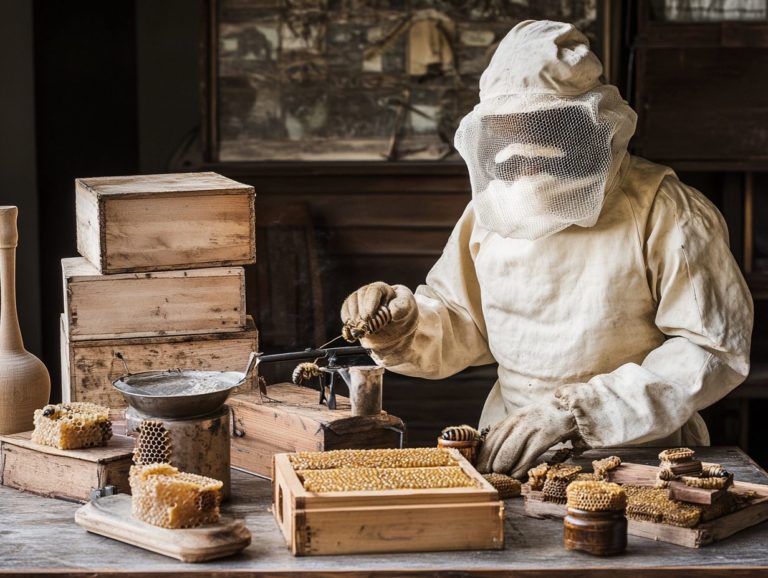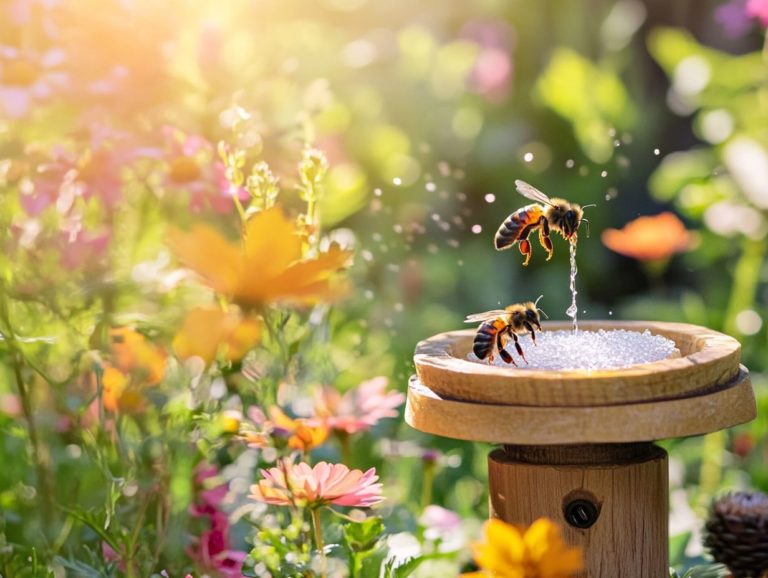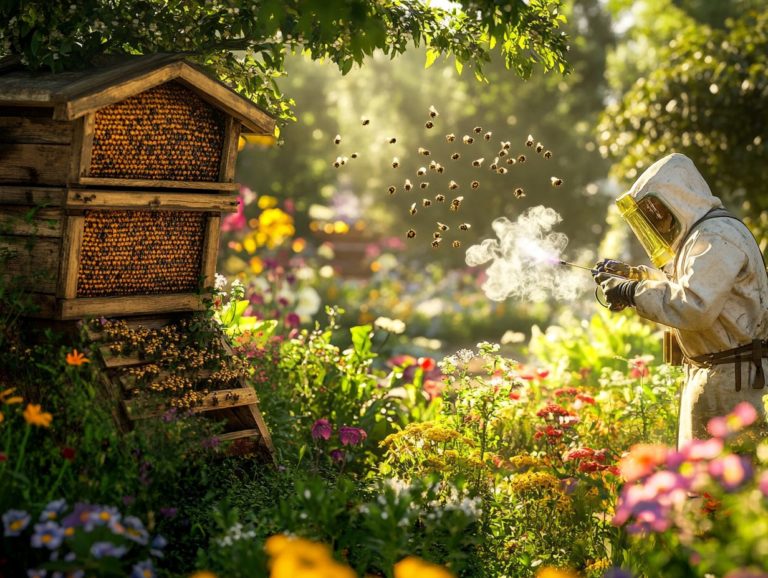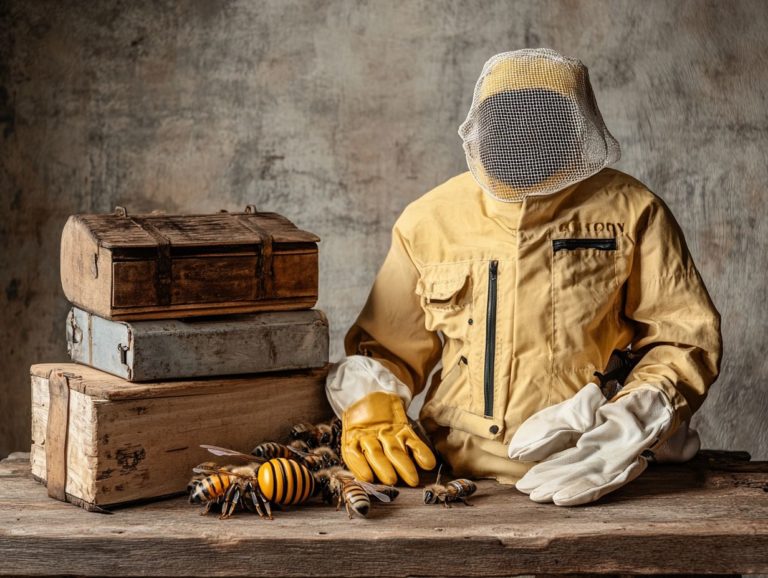Understanding Bee Behavior Around Equipment
Bees, especially the common honeybee, play a vital role in our ecosystem. Their fondness for certain types of equipment, like hive tools and smokers, can create challenges for both humans and machinery.
This article explores why bees are attracted to beekeeping tools, the potential hazards they may pose, including damage to honey extractors, and the signs of bee activity you should watch for.
It also outlines practical prevention strategies. These include using bee repellents and maintaining a clean environment. We will provide guidance on what to do if you find yourself near these buzzing insects.
Whether you are a homeowner, a farmer, or a hobbyist, understanding bee behavior such as robbing behavior and the roles of the queen bee and worker bees can empower you to navigate these encounters with confidence and safety.
Contents
- Key Takeaways:
- Why Are Bees Attracted to Equipment?
- What Are the Dangers of Bees Around Equipment?
- What Are The Signs Of Bee Activity Around Equipment?
- How To Prevent Bees From Being Attracted To Equipment?
- What to Do If Bees Buzz Around Your Equipment!
- Frequently Asked Questions
- What is bee behavior?
- Why is it important to understand bee behavior around equipment?
- What types of equipment do bees typically interact with?
- How do bees typically behave around equipment?
- What precautions should be taken when working with bees near equipment?
- Can bee behavior be influenced by the type of equipment present in their environment?
Key Takeaways:
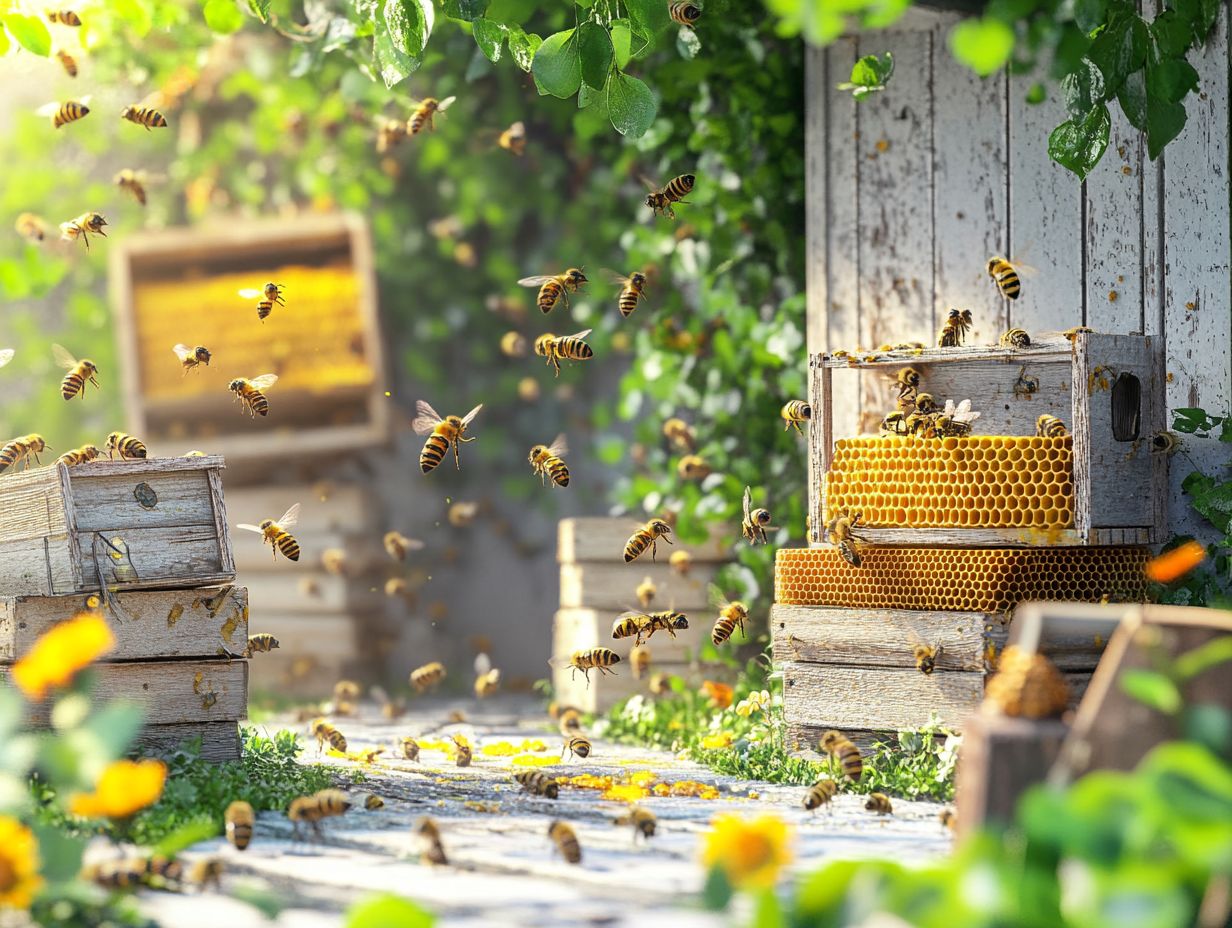
- Bees are naturally attracted to beekeeping tools due to their bright colors and vibrations. It’s important to take preventive measures to keep them away, such as using bee brushes and gloves.
- Bees around equipment can pose dangers by damaging tools, like honey extractors, or stinging humans. Be aware of their presence and take necessary precautions.
- Regular maintenance and cleaning of your tools, using bee repellents, and creating a bee-friendly environment can help prevent bees from being attracted to equipment.
Why Are Bees Attracted to Equipment?
Bees, especially the common honeybee, have an innate attraction to various beekeeping tools, often drawn in by the scents they emit or by their association with nectar sources. This attraction intensifies with hive tools, smokers, and protective gear like jackets with hat veils, beekeeping gloves, and bee brushes, which can signal to bees that foraging opportunities await nearby.
Understanding the reasons behind this attraction is essential for you as a beekeeper. It enables you to manage your tools efficiently while minimizing unwelcome interactions. Using essential beekeeping tools and starter kits can aid in this process.
What Types of Equipment Are Bees Attracted To?
Bees are drawn to various beekeeping equipment, including hive tools, smokers, bee boxes, and honey extractors. These items often emit enticing scents or contain residues that mimic nectar and pollen sources.
Consider hive tools: as you use them for scraping and prying, they accumulate sticky propolis a sticky substance bees make from tree resin and honey remnants that attract bees. Smokers, with their aromatic smoke designed to calm bees, can also pull them in when those lingering scents are strong. Well-maintained bee boxes, particularly those made from untreated wood, can release natural pheromones that pique a bee’s keen sense of smell. Using Warre hives and Langstroth hives influences how bees behave and are attracted.
To effectively manage these attractions, you should:
- Regularly clean your equipment to eliminate any residual scents.
- Maintain proper organization to minimize cross-contamination.
- Store tools in airtight containers when not in use, reducing the likelihood of inviting bees into unwanted spaces.
What Are the Dangers of Bees Around Equipment?
The presence of bees around your beekeeping tools can introduce various risks. These include the potential for bee stings and disturbances that may impact the overall health and maintenance of your colony, especially concerning the queen bee and worker bees.
Stay alert and watchful your attention can protect you and your bees! Leaving equipment unattended can trigger heightened foraging activity, which may escalate into aggressive behavior if the bees sense a threat.
Don t wait start applying these tips today to keep your beekeeping experience safe and enjoyable!
Can Bees Cause Damage To Equipment?
Yes, bees can indeed cause damage to your beekeeping equipment, especially through their construction of honeycomb and the sticky substance propolis that they use to seal gaps. This can disrupt your hive management and create maintenance challenges. Proper use of hive tools and regular maintenance can help mitigate these issues.
These industrious little creatures are known for their hardworking nature, leading to the rapid accumulation of honeycomb that can obstruct access to crucial hive components. Their affinity for propolis can complicate your routine inspections and cleanings, both vital for maintaining hive health. Staying informed about hive management techniques through beekeeping books can also be beneficial.
If you neglect to monitor and manage this buildup regularly, serious consequences may arise, such as reduced airflow, elevated moisture levels, and even pest infestations. These threats can jeopardize the overall wellbeing of your colony.
Staying proactive with your hive inspections and maintenance, such as DIY honey extraction, is essential for ensuring the longevity and productivity of your beekeeping endeavors.
Can Bees Cause Harm To Humans?
Bees can sting, especially if you accidentally disturb aggressive worker bees near beekeeping equipment. This can lead to allergic reactions in some individuals, including severe cases that could result in anaphylactic shock, a serious allergic reaction that can be life-threatening.
These reactions can range from mild swelling and discomfort to more severe cases requiring immediate medical attention. Understanding bee behavior, including signs of aggression like robbing behavior, is crucial for minimizing these risks since bees are more inclined to sting when they feel threatened or their hive is disturbed.
To reduce the likelihood of stings, you can:
- Wear protective clothing
- Utilize smoke to calm the bees
- Move slowly around the hive
It s also important to recognize signs of aggression in bees, such as loud buzzing or erratic flying patterns. By doing so, you not only protect yourself but also help ensure the safety of others while engaging with these critical pollinators. Wearing a jacket with a hat veil can provide added protection during such encounters.
What Are The Signs Of Bee Activity Around Equipment?
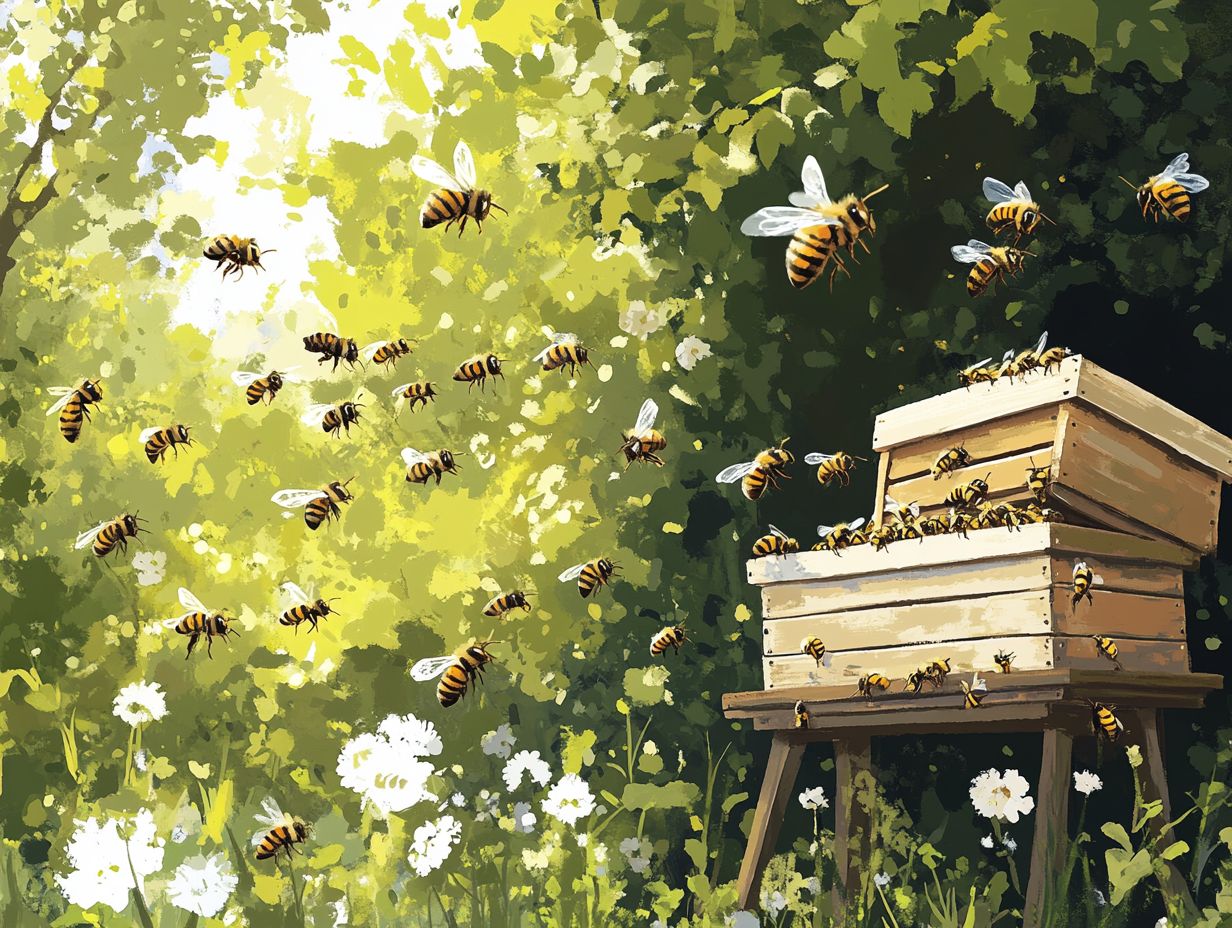
Recognizing the signs of bee activity around your beekeeping equipment is crucial for maintaining the health and management of your hives. Pay attention to common indicators such as robbing behavior, which includes:
- Heightened flight activity from worker bees,
- The delightful buzzing sounds they produce, and
- The sight of foraging bees bustling around the hive boxes.
These signs will provide valuable insights into the level of bee activity and their interactions with your equipment, allowing you to maintain a thriving beekeeping operation. Regularly consulting beekeeping books can help you stay informed about these signs and their implications.
Visual Signs
When observing visual signs of bee activity around your equipment, you ll likely see a multitude of worker bees buzzing in and out of the hive boxes. This lively movement indicates active foraging near their preferred nectar sources. Investing in beekeeping starter kits can help you better manage these observations.
You might catch sight of a flurry of bees energetically darting from the entrance of the hive, accompanied by that distinctive hum that signifies a vibrant, bustling colony at work. These patterns of rapid take-offs and organized returns reflect not only the health of the colony but also the availability of resources in their surroundings. This is particularly evident in well-managed Langstroth hives and Warre hives.
As you move closer to the equipment, you may see bees landing on nearby flowers or the equipment itself, showcasing their unwavering dedication to collecting pollen and nectar. These visual cues are invaluable for beekeepers, providing essential insights for management decisions. Observing these cues can also assist in making informed decisions about DIY honey extraction.
Audible Signs
Audible signs of bee activity around your equipment often present themselves as a melodic buzzing. This indicates the presence of worker bees as they communicate and navigate their surroundings.
The sounds, along with a variety of other auditory cues, serve as essential indicators of the colony’s health and vitality. A steady, rhythmic buzzing usually suggests that the bees are actively foraging and flourishing. This is a clear indication of a well-functioning hive dynamic.
On the other hand, erratic or faint sounds may hint at stress within the colony. This stress could stem from environmental disturbances, diseases, or improper hive management techniques.
For those engaged in beekeeping, tuning in to these audio signals can be invaluable in assessing the condition of the hive. It can also help determine when interventions are necessary. Cultivating an understanding of the auditory landscape surrounding your beekeeping equipment not only enhances your management strategies but also nurtures a deeper connection with these extraordinary pollinators.
Consulting beekeeping books can refine your understanding of these auditory cues.
How To Prevent Bees From Being Attracted To Equipment?
Regular maintenance and cleaning are key to keeping bees away from your beekeeping equipment. Engaging in a blend of regular maintenance and thorough cleaning is essential.
Utilizing bee repellents and wearing beekeeping gloves can further enhance your efforts. Creating a bee-friendly environment minimizes unnecessary interactions with the bees.
By adopting these strategies, you can effectively manage your equipment while significantly reducing the likelihood of unwanted bee encounters. This helps keep your colony healthy and productive.
Regular Maintenance And Cleaning
Regular maintenance and cleaning of your beekeeping equipment are essential for minimizing bee attraction and ensuring the health of your hive. Using DIY honey extraction techniques can help maintain cleanliness and efficiency.
Establishing a consistent cleaning routine effectively reduces the risk of diseases and pests that often thrive in untidy environments. Neglecting to keep your tools clean may lead to the buildup of residues, mold, and harmful pathogens that could inadvertently affect your bees.
A tidy workspace simplifies the inspection of your hive s overall condition. It also allows you to identify potential issues early on. Make cleanliness a priority to ensure your colonies thrive!
By prioritizing cleanliness, you promote the well-being of your colonies while simultaneously enhancing your overall productivity and honey yield. It’s truly a win-win for you and your bees.
Using Bee Repellents and Hive Types
Using bee repellents can be a smart strategy to keep bees at bay, especially when you’re tending to your equipment during hive management activities. Whether you use a Langstroth hive or a Warre hive, understanding the various types of bee repellents available can greatly enhance your effectiveness in this endeavor.
You have options that range from natural ingredients like citronella or peppermint oil to synthetic chemical formulations specifically designed to target the sensory receptors of bees. Most repellents work by emitting scents that bees find unappealing, encouraging them to steer clear of your vicinity.
Timing is essential; applying these products during peak foraging hours when bees are most active minimizes any disruption to their natural behaviors. It’s crucial to use these repellents responsibly, striking a balance between managing your equipment effectively and preserving the vital ecological role that bees play.
By doing so, you help ensure that their populations remain healthy and robust.
Creating A Bee-Friendly Environment
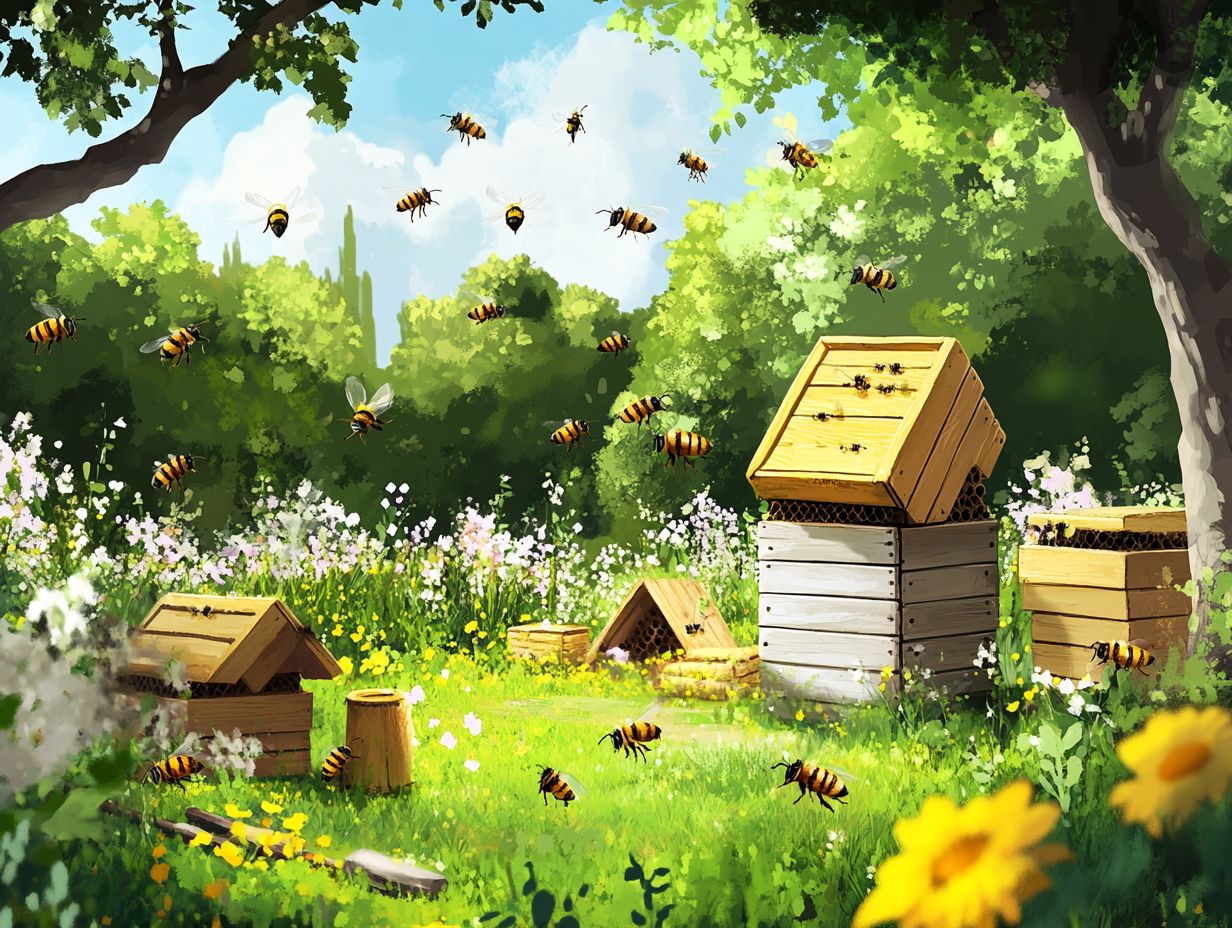
Creating a bee-friendly environment means managing nectar sources and habitats in a way that allows worker bees to thrive. This helps prevent them from being overly attracted to your beekeeping equipment.
To achieve this, you need a thoughtful approach that combines a variety of flowering plants that bloom at different times throughout the season. This ensures a steady food supply for pollinators.
Incorporating natural barriers like hedgerows or strategically placed water features can guide bees away from equipment areas. They still provide essential resources they require.
Designing landscapes that include a mix of open spaces for foraging and sheltered areas for nesting contributes to a healthier ecosystem. By considering these elements, you can enhance local biodiversity while maintaining practical boundaries to minimize unwarranted bee interactions with your tools and machinery.
What to Do If Bees Buzz Around Your Equipment!
When you find yourself near bees by your beekeeping equipment, stay calm. This is your best bet for safety and keeping the bees happy!
Understanding bee behavior will help you decide whether to keep managing your equipment or to seek help. By wearing protective gear, you can significantly reduce risks and handle the situation with confidence.
Stay Calm and Still
Remain calm and still when bees are buzzing around your equipment. This is essential to prevent triggering any aggressive behavior from the colony.
Bees, much like many living beings, can pick up on emotions and changes in their environment. By minimizing sudden movements, you create a setting that feels less threatening to these busy bees.
Practicing steady, slow breathing can help reduce anxiety while keeping your hands and body motionless. Wearing light-colored clothing can decrease disturbances, as darker tones might be perceived as more predatory.
Learning to read bee behavior like observing their flight patterns and interpreting their buzzing can enhance your ability to coexist harmoniously with these busy bees.
Call a Professional Beekeeper
If bees around your beekeeping equipment feel overwhelming or pose a danger, reaching out to a professional beekeeper is advisable. They can provide expert assistance and ensure the well-being of your hive.
These specialists possess a wealth of knowledge about bee behavior and the experience necessary to handle various scenarios safely and efficiently. Whether you’re faced with a swarm in your garden or an established hive showing unusual activity, their expertise is invaluable.
By engaging a professional, you can relieve the stress of managing unpredictable bees. They have the best practices for handling stings, effective methods for hive relocation, and advice on honey extraction.
Use Protective Gear
Wearing protective gear when working near bees is essential for your safety. It minimizes the risk of bee stings.
Specialized beekeeping outfits come in various designs, often featuring jackets with built-in hat veils that shield your face and neck from stings. High-quality gloves, made of leather or thicker synthetic materials, offer a solid barrier against bee attacks while letting you maintain dexterity.
The right attire enhances your safety and boosts your confidence as a beekeeper. This confidence is vital when managing your colonies, ensuring tasks like honey extraction or hive maintenance can be carried out smoothly.
Remove The Equipment If Possible
If possible, removing beekeeping equipment from the vicinity of active bees can significantly reduce the risk of unwanted interactions and make it easier to manage hives.
Careful planning is necessary for this task, taking into account the bees’ behavior and activity patterns. By evaluating the colonies’ peak times and choosing phases of lower activity, you can effectively minimize disturbances when managing a Langstroth hive (a type of beehive with removable frames for easy access) or a Warre hive (a smaller, more natural style of beehive that promotes bee health).
Establishing a designated area away from the hives ensures that the bees remain undisturbed during this process. It s crucial to wear protective gear while handling any equipment and to move gently, as sudden gestures can easily agitate the bees, leading to stressful encounters.
By planning wisely, you can swiftly and safely remove beekeeping tools, ensuring a peaceful environment with your buzzing friends!
Frequently Asked Questions
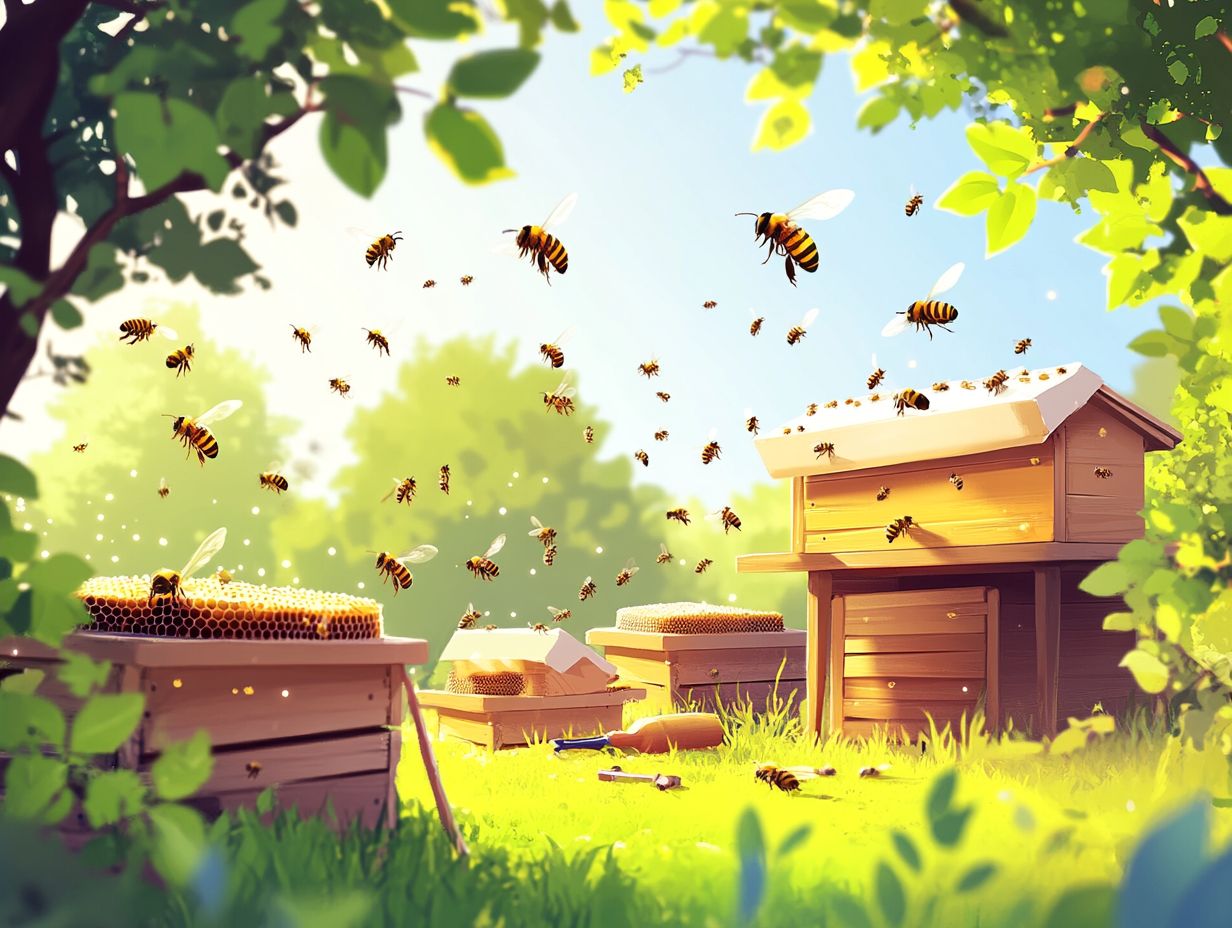
What is bee behavior?
Bee behavior includes how they act and react to their surroundings.
Why is it important to understand bee behavior around equipment?
Understanding bee behavior around equipment is crucial as it helps prevent accidents and injuries while promoting better management of bee colonies.
What types of equipment do bees typically interact with?
Bees may interact with different equipment, including beehives, beekeeping tools, and farm equipment used near their habitats.
How do bees typically behave around equipment?
Bees may investigate, gather materials, or even establish new hives if the equipment offers suitable shelter.
What precautions should be taken when working with bees near equipment?
When working with bees near equipment, it is essential to wear protective gear, move slowly and calmly, and avoid sudden loud noises or vibrations that may disturb the bees.
Can bee behavior be influenced by the type of equipment present in their environment?
Yes, bee behavior can be influenced by the type of equipment present. For instance, bees may be attracted to specific colors or materials commonly used in beekeeping equipment.

